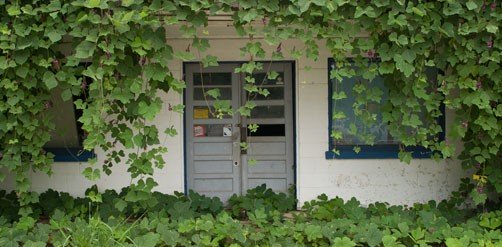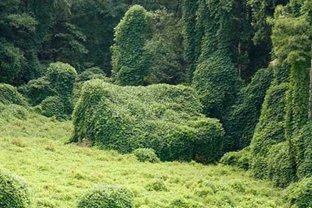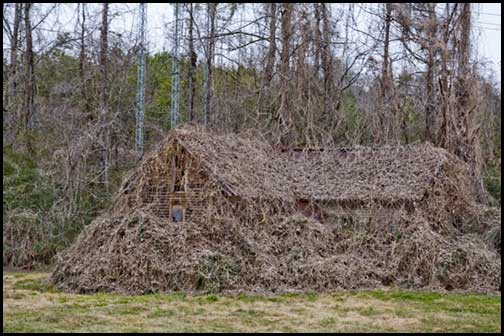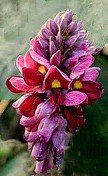The Infamous Kudzu Plant
Its Uses and Control Methods

The first kudzu plant was first introduced in the U.S. from Japan during in the 1800’s. The U.S. government paid farmers to plant kudzu as a fast growing ground cover and as a forage crop. Unfortunately, it was discovered too late that kudzu was more at home in the Southern U.S. than it was in its native lands. When left to itself, it quickly escaped and continued growing well beyond its borders, taking over everything in its path.

Kudzu is a fast growing vine that coils and climbs anything in its path. At a growth rate of one foot each day, it can covered entire trees, fields, fences, and even abandoned cars and houses. The southern U.S. has been hit the hardest, but kudzu has been discovered as far north as Canada. Due to its fast growth, it is also called the “mile a minute vine” and “the vine that ate the South” referring to the southern U.S.

Kudzu plants lose their leaves in winter leaving this house in a prison of vines. Kudzu spreads by production of below and above ground lateral stems called rhizomes and stolons. These stems will root at the nodes. Each node will form a new plant that is a clone of the mother plant. In this way a single kudzu plant can quickly multiply and spread. Kudzu also produces seed pods with viable seed. However, the seeds may require several seasons in the soil to germinate. This increases the difficulty of controlling kudzu.
photo notes: Photographer is Jack Anthony. The three photos above are used by permission.
Kudzu Plant Identification
Be careful when handling Kudzu Plants. I have often seen Poison Ivy plants running along the length of the Kudzu vines. Before you start pulling and separating the vines, be sure to check them out carefully first. Below are some of the things to consider when seeking to identify Kudzu.
- Long, bristly vines that can be over 30 feet in length.
- Vines drop their leaves in winter.
- Large leaves up to 5 to 6 inches long.
- Leaves may have 3 lobes, while other may have no lobes.
- Produces short seed pods that are covered with fine bronze hairs.
- Violet to reddish purple flowers.
Long woody vines can extend many feet in length. The vine has fine, bristly hairs covering it and some may find it uncomfortable to handle.
The plant spreads by the production of rhizomes and stolons. These are not roots or vines, but horizontal stems that produce roots and vines along their length.

Leaves are slightly longer then they are wide. They can be up to 6 inches long. Some may have three lobes with the middle lobe extending out the longest. Leaves can be dark green or somewhat lighter.
Seed pods are green and bronze and grow in clusters about 2 inches long. They are covered with fine hairs.
Kudzu Flower Photo: The vine produces a long stem of beautiful purple to redish-purple flowers. There is a spot of yellow on each stem of flowers. Each flower is on a separate petiole that connects to the stem.
Uses for Kudzu Plants
Considering all the damage Kudzu plants do, it still has many fans. Maybe they are just making the best of a bad situation. However, kudzu does make a good forage crop. It is high in nitrogen and actually replaces nitrogen in the soil.
Kudzu leaves are edible and can be cooked like other vegetables. This could become our revenge. Maybe we could eat the plant that ate the south. The bare vines are used for craft projects and basket making.
The flowers are also edible and can be made into jelly. There are several kudzu recipes for the different plant parts.
Kudzu has limitations, however. Although it can be bailed, it is more difficult because of the vines. It is deciduous and drops its leaves in winter, so it provides no winter crop. It appears to have an endless amount of leaves, but they are mostly on the outside of the plant. The plant gets so thick that leaves do not grow well on the inside because of a lack of sunlight.
When kudzu is over-grazed, the plant will start to weaken and will start to die back within a few years. This is helpful on farms with lots of goats, cattle and other animals. The animals, especially goats, will eat the leaves and delicate stems that help keep kudzu under control.
Methods of Controlling Kudzu Plants
Kudzu plants are easy to control when it first starts growing. It is more difficult to control when it is located in forests or spread over large pastures. Control measures should start as soon as it is discovered. Once it has spread over a large area the expense of controlling and managing kudzu can be enormous and time consuming.
Non-Chemical Control Methods for Kudzu Control
You may find one or more suggestions below helpful in controlling kudzu plants.
- In smaller patches, cut the vines and dig up roots, if possible.
- Keep kudzu mowed when found growing on the ground. Removing the leaves is the goal.
- Strip vines off trees and bushes, etc.
- Allow animals to graze on the plants.
- Cover the plants with black plastic.
- Keep covering plants under heavy mulch, such as grass clipping.
- Try using a tractor with a “rock rake” or equivalent to tear as much vine out of the ground as possible.
When you first notice the plant growing on your property, cut it back to the ground and strip the vines away from bushes or trees, etc. Dig up the roots as best you can,, especially for a small patch. Keep watch on the surrounding area for any reemergence.
For larger patches on the ground, mow the plant regularly as low as you can. Use a string trimmer if necessary. Cut as many leaves and branches as possible. Keep in mind that cutting vines might stimulate more vine growth. However, it takes energy to grow more vines. Like other plants, leaves are necessary for photosynthesis. Without leaves the plants will begin to decline.
Chemical Control for Kudzu
- Only a limited number of herbicides will effectively kill kudzu.
- Use herbicides containing Triclopyr for range grass, roadsides, fences, etc.
- Herbicides containing glyphosate (Round-Up, Rodeo, etc.)
Herbicides Containing Triclopyr
Kudzu plants are easy to control with chemical herbicides. For non-crop farmland, roadsides, pastures, fencerows, etc. use a product containing Triclopyr. Products include Crossbow, Garlon 4, Gordon’s Brush Killer, and others.
Triclopyr is now available to homeowners in many states. One product is Turflon Ester from Monterey Lawn and Garden Products that specialize in homeowner products. I want to thank Monterey's Jennifer McNulty for providing me with their homeowner Triclopyr product information. Their website is Monterey Lawn and Garden There are other companies as well. Triclopyr will kill many weeds, flowers, brush, vines, small trees, and many other things it touches. It will not harm grass when used properly.
Herbicides Containing Glyphosate to Kill Kudzu
Glyphosate is an all vegetation killer. That means it will kill all grasses and plants it comes in contact with. It will not always do well on brushy weeds, but will offer fairly good control of kudzu vine. It has no residual so it will only kill the plants it comes in contact with when sprayed.
Products include: Round-Up, Rodeo, Touchdown, and many other brands.
Be sure to read the entire herbicide label before use. Make sure you have all the Personal Protective Equipment (PPE) including clothing, boots, etc. before you open the container.
Poison Ivy Identification and Control
Poison ivy plants cause severe rashes, itching, and blistering. The best defense against this toxic plant is instant identification. Find help with identification, control methods, and treatment options.
Kudzu Plants to Lawn Care Academy Home



